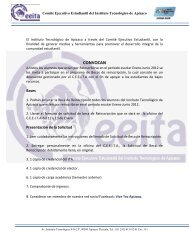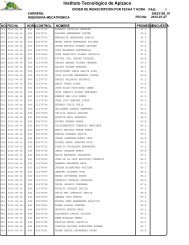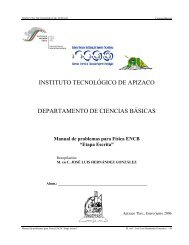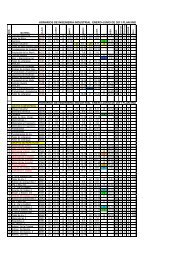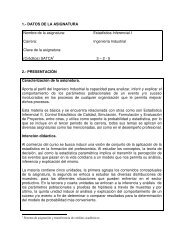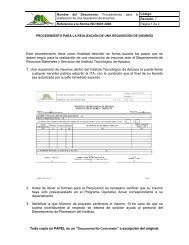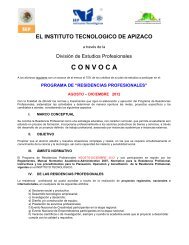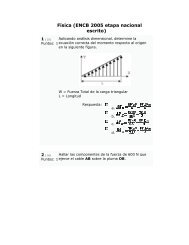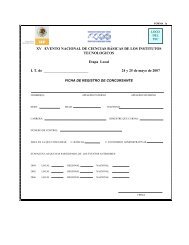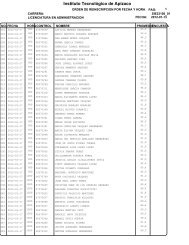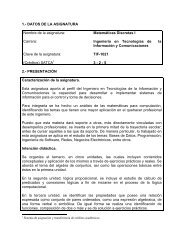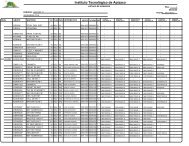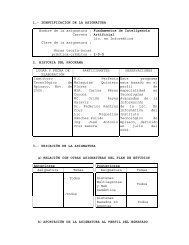bosquejo de funciones con apoyo de calculadoras graficadoras o ...
bosquejo de funciones con apoyo de calculadoras graficadoras o ...
bosquejo de funciones con apoyo de calculadoras graficadoras o ...
Create successful ePaper yourself
Turn your PDF publications into a flip-book with our unique Google optimized e-Paper software.
INSTITUTO TECNOLOGICO DE APIZACO<br />
Ciencias Básicas<br />
INSTITUTO TECNOLÓGICO DE APIZACO<br />
DEPARTAMENTO DE CIENCIAS BÁSICAS<br />
PRIMER CONGRESO DE CIENCIAS BÁSICAS<br />
LA ENSEÑANZA Y APLICACIÓN DE LAS CIENCIAS BÁSICAS<br />
Bosquejo <strong>de</strong> <strong>funciones</strong> <strong>con</strong> <strong>apoyo</strong> <strong>de</strong> <strong>calculadoras</strong> <strong>graficadoras</strong><br />
M. en C. JOSÉ LUIS HERNÁNDEZ GONZÁLEZ<br />
Alumno (a): ________________________________________________<br />
www.itapizaco.edu.mx/~joseluis<br />
joseluis@itapizaco.edu.mx<br />
Apizaco Tlax., 25, 26 y 27 <strong>de</strong> octubre <strong>de</strong> 2006<br />
”Bosquejo <strong>de</strong> <strong>funciones</strong> <strong>con</strong> <strong>apoyo</strong> <strong>de</strong> <strong>calculadoras</strong> <strong>graficadoras</strong>” M. en C. José Luis Hernán<strong>de</strong>z González 1 / 33
INSTITUTO TECNOLOGICO DE APIZACO<br />
Ciencias Básicas<br />
ÍNDICE<br />
BOSQUEJO DE FUNCIONES............................................................................................................ 3<br />
Introducción ..................................................................................................................................... 3<br />
Función............................................................................................................................................. 3<br />
Representación ................................................................................................................................. 3<br />
Listas ................................................................................................................................................ 4<br />
Operaciones.......................................................................................................................................... 5<br />
Tipos <strong>de</strong> gráficos .................................................................................................................................. 5<br />
Tipos <strong>de</strong> marcas................................................................................................................................6<br />
Gráfica <strong>de</strong> nube <strong>de</strong> puntos, editor <strong>de</strong> ecuaciones ............................................................................. 7<br />
Evaluación <strong>de</strong> <strong>funciones</strong> (home) ...................................................................................................... 9<br />
La ecuación <strong>de</strong> la recta que une dos puntos. ........................................................................................ 9<br />
Gráfica <strong>de</strong> una función, editor <strong>de</strong> ecuaciones ................................................................................ 10<br />
Definición <strong>de</strong> la función que pasa por dos puntos ......................................................................... 11<br />
Transformaciones <strong>de</strong> <strong>funciones</strong>.......................................................................................................... 18<br />
Desplazamientos............................................................................................................................. 18<br />
Estiramientos y compresiones verticales........................................................................................ 19<br />
Estiramientos y compresiones horizontales ................................................................................... 19<br />
Reflexiones..................................................................................................................................... 19<br />
Dominio y recorrido........................................................................................................................... 20<br />
Otras <strong>funciones</strong> básicas ...................................................................................................................... 21<br />
Funciones trigonométricas ................................................................................................................. 22<br />
Combinación <strong>de</strong> <strong>funciones</strong>................................................................................................................. 30<br />
Bibliografía......................................................................................................................................... 33<br />
”Bosquejo <strong>de</strong> <strong>funciones</strong> <strong>con</strong> <strong>apoyo</strong> <strong>de</strong> <strong>calculadoras</strong> <strong>graficadoras</strong>” M. en C. José Luis Hernán<strong>de</strong>z González 2 / 33
INSTITUTO TECNOLOGICO DE APIZACO<br />
Ciencias Básicas<br />
BOSQUEJO DE FUNCIONES<br />
Introducción<br />
Aunque en la actualidad es fácil graficar una función o un <strong>con</strong>junto <strong>de</strong> puntos por medio <strong>de</strong> software<br />
o una calculadora graficadora, es importante que los alumnos <strong>de</strong> nivel licenciatura puedan bosquejar<br />
una función a mano basados en algunos puntos o una serie <strong>de</strong> transformaciones <strong>de</strong> la función básica.<br />
Función<br />
Una función f es una regla que asigna a cada elemento x <strong>de</strong> un <strong>con</strong>junto A exactamente un elemento,<br />
llamado f(x), <strong>de</strong> un <strong>con</strong>junto B.<br />
x •<br />
a •<br />
•<br />
A<br />
f<br />
• y = f(x)<br />
• f(a)<br />
•<br />
B<br />
Una función es<br />
{(x, y)| x ∈ A}<br />
Representación<br />
La representación <strong>de</strong> una función pue<strong>de</strong> ser:<br />
a) Verbal<br />
b) Tabular<br />
c) Gráfica<br />
d) Analítica<br />
x y<br />
-3 9<br />
-2 4<br />
-1 1<br />
0 0<br />
1 1<br />
2 4<br />
3 9<br />
2<br />
y = x<br />
Tabular Gráfica Análitica<br />
”Bosquejo <strong>de</strong> <strong>funciones</strong> <strong>con</strong> <strong>apoyo</strong> <strong>de</strong> <strong>calculadoras</strong> <strong>graficadoras</strong>” M. en C. José Luis Hernán<strong>de</strong>z González 3 / 33
INSTITUTO TECNOLOGICO DE APIZACO<br />
Ciencias Básicas<br />
Generalmente, se acostumbra bosquejar una gráfica elaborando una tabla, para lo cual se da una<br />
serie <strong>de</strong> valores para x, <strong>con</strong> la función f(x) se proce<strong>de</strong> a calcular el valor <strong>de</strong> la y, <strong>de</strong> manera tal, que<br />
y = f(x), aunque esto ya no es necesario <strong>con</strong> un programa <strong>de</strong> computo o una calculadora graficadora.<br />
Ejemplo. Sea la función y = x 2 + 1<br />
Es <strong>de</strong>cir f(x) = (x) 2 +1<br />
Si x = -3<br />
f(-3) = (-3) 2 +1= 10<br />
f(-2) = (-2) 2 +1= 5<br />
f(-1) = (-1) 2 +1= 2<br />
f( 0) = ( 0) 2 +1= 1<br />
f( 1) = ( 1) 2 +1= 2<br />
f( 2) = ( 2) 2 +1= 5<br />
f( 3) = ( 3) 2 +1= 10<br />
x Y<br />
-3 10<br />
-2 5<br />
-1 2<br />
0 1<br />
1 2<br />
2 5<br />
3 10<br />
Ese <strong>con</strong>junto <strong>de</strong> valores lo po<strong>de</strong>mos manejar <strong>de</strong> manera más apropiada mediante una lista.<br />
Listas<br />
Una lista es un <strong>con</strong>junto <strong>de</strong> valores separado por comas entre llaves.<br />
{-3}<br />
{-3,-2,-1,0,1,2,3}<br />
{2,1}<br />
{a,b,c,e,d}<br />
Po<strong>de</strong>mos almacenar una lista una variable mediante la tecla §<br />
Ejemplo.<br />
Los siguientes datos correspon<strong>de</strong>n a la función y = x 2 +1<br />
En home introduzca los datos en las<br />
variables listax, listay.<br />
{-3,-2,-1,0,1,2,3}§listax¸<br />
{10,5,2,1,2,5,10}§listay¸<br />
”Bosquejo <strong>de</strong> <strong>funciones</strong> <strong>con</strong> <strong>apoyo</strong> <strong>de</strong> <strong>calculadoras</strong> <strong>graficadoras</strong>” M. en C. José Luis Hernán<strong>de</strong>z González 4 / 33
INSTITUTO TECNOLOGICO DE APIZACO<br />
Ciencias Básicas<br />
También es posible efectuar operaciones <strong>con</strong> las listas, tal y como se hace en aritmética o álgebra.<br />
Operaciones<br />
Suma + Listax+Listay<br />
Resta – Listax-Listay<br />
Multiplicación *<br />
Listax*Listay<br />
División / Listax/Listay<br />
Raíz cuadrada √<br />
√( Listax)<br />
Valor absoluto | |<br />
abs(Listax)<br />
Se pue<strong>de</strong>n hacer las siguientes gráficas en la calculadora:<br />
Tipos <strong>de</strong> gráficos<br />
Nube <strong>de</strong><br />
puntos<br />
Líneas y<br />
puntos<br />
”Bosquejo <strong>de</strong> <strong>funciones</strong> <strong>con</strong> <strong>apoyo</strong> <strong>de</strong> <strong>calculadoras</strong> <strong>graficadoras</strong>” M. en C. José Luis Hernán<strong>de</strong>z González 5 / 33
INSTITUTO TECNOLOGICO DE APIZACO<br />
Ciencias Básicas<br />
Tipos <strong>de</strong> marcas<br />
Caja<br />
Cruz<br />
Signo Más<br />
Cuadro<br />
Punto<br />
”Bosquejo <strong>de</strong> <strong>funciones</strong> <strong>con</strong> <strong>apoyo</strong> <strong>de</strong> <strong>calculadoras</strong> <strong>graficadoras</strong>” M. en C. José Luis Hernán<strong>de</strong>z González 6 / 33
INSTITUTO TECNOLOGICO DE APIZACO<br />
Ciencias Básicas<br />
Gráfica <strong>de</strong> nube <strong>de</strong> puntos, editor <strong>de</strong> ecuaciones<br />
Presione ¹#, mueva el cursor<br />
hasta Plot 1: y presione ¸<br />
Seleccione Plot Type …Scatter<br />
Mark………..Box<br />
Y escriba en x, y<br />
x…………….listax<br />
y…………….listay<br />
Se muestra el tipo <strong>de</strong> gráfico y el<br />
valor <strong>de</strong> las listas a graficar<br />
Del menú seleccione F2:Zoom,<br />
9:ZoomData y presione ¸<br />
La gráfica será ajustada al <strong>con</strong>junto<br />
<strong>de</strong> valores <strong>de</strong> las listas.<br />
”Bosquejo <strong>de</strong> <strong>funciones</strong> <strong>con</strong> <strong>apoyo</strong> <strong>de</strong> <strong>calculadoras</strong> <strong>graficadoras</strong>” M. en C. José Luis Hernán<strong>de</strong>z González 7 / 33
INSTITUTO TECNOLOGICO DE APIZACO<br />
Ciencias Básicas<br />
La función más sencilla correspon<strong>de</strong> a una <strong>con</strong>stante.<br />
Dibuje la función <strong>de</strong> una <strong>con</strong>stante y elabore una tabla xy<br />
x<br />
y<br />
y = ____<br />
Otra función sencilla correspon<strong>de</strong> a:<br />
x<br />
y<br />
y = x<br />
Elabore la gráfica <strong>de</strong>:<br />
x<br />
y<br />
y = x 2<br />
”Bosquejo <strong>de</strong> <strong>funciones</strong> <strong>con</strong> <strong>apoyo</strong> <strong>de</strong> <strong>calculadoras</strong> <strong>graficadoras</strong>” M. en C. José Luis Hernán<strong>de</strong>z González 8 / 33
INSTITUTO TECNOLOGICO DE APIZACO<br />
Ciencias Básicas<br />
Evaluación <strong>de</strong> <strong>funciones</strong> (home)<br />
A estas <strong>funciones</strong> les <strong>de</strong>nominaremos <strong>funciones</strong> básicas, y también las po<strong>de</strong>mos almacenar en<br />
alguna variable para po<strong>de</strong>r evaluarlas tal y como se hace a mano.<br />
Sea la función f(x) = x 2 , almacenarla en la variable f(x)<br />
x^2§f(x)<br />
Si se quiere evaluar cuando x = 2,<br />
entonces <strong>de</strong>bemos escribir<br />
f(2) ¸<br />
Si x = c<br />
f(c) ¸<br />
Si x = c + 1<br />
f(c+1) ¸<br />
Si el valor <strong>de</strong> x es una lista entonces<br />
f(listax) ¸<br />
Actividad: Definir algunas <strong>funciones</strong> y evaluarlas.<br />
Se pue<strong>de</strong>n <strong>de</strong>finir <strong>funciones</strong> más complicadas tales como f(x 1 , x 2 , … x n ), don<strong>de</strong> x 1 , x 2 , …, x n se<br />
<strong>de</strong>nominan parámetros.<br />
Ejemplo.<br />
Defina como una función llamada fuerza <strong>con</strong> la fórmula F = ma y evalúe cuando m = 3 y a = 2<br />
m*a§fuerza(m,a)¸<br />
fuerza(3,2)¸<br />
La ecuación <strong>de</strong> la recta que une dos puntos.<br />
y<br />
A<br />
•<br />
(x 1 , y 1 )<br />
B<br />
• (x 2 , y 2 )<br />
m = tan( θ )<br />
x<br />
En<strong>con</strong>trar la ecuación <strong>de</strong> la recta que pasa por los puntos (0, 0) y (1, 1)<br />
”Bosquejo <strong>de</strong> <strong>funciones</strong> <strong>con</strong> <strong>apoyo</strong> <strong>de</strong> <strong>calculadoras</strong> <strong>graficadoras</strong>” M. en C. José Luis Hernán<strong>de</strong>z González 9 / 33
INSTITUTO TECNOLOGICO DE APIZACO<br />
Ciencias Básicas<br />
Gráfica <strong>de</strong> una función, editor <strong>de</strong> ecuaciones<br />
Antes que nada, es necesario ajustar<br />
la ventana don<strong>de</strong> se visualizarán las<br />
gráficas, presionado ¹$<br />
En el editor <strong>de</strong> ecuaciones, grafique<br />
la función y = x.<br />
Presione ¹#<br />
Mueva el cursor hasta y1 =<br />
Presione ¸ y escriba x<br />
Presione ¹%<br />
Ajuste la ventana <strong>de</strong> forma que x y<br />
y sean <strong>de</strong>l mismo tamaño<br />
presionando F2 Zoom,<br />
5:Zoomsqr<br />
El resultado es:<br />
Actividad: Graficar algunas <strong>funciones</strong>.<br />
”Bosquejo <strong>de</strong> <strong>funciones</strong> <strong>con</strong> <strong>apoyo</strong> <strong>de</strong> <strong>calculadoras</strong> <strong>graficadoras</strong>” M. en C. José Luis Hernán<strong>de</strong>z González 10 / 33
INSTITUTO TECNOLOGICO DE APIZACO<br />
Ciencias Básicas<br />
Pue<strong>de</strong> hacer una gráfica <strong>de</strong> puntos escribiendo en home la función newplot n,tipo,listax,listay<br />
Don<strong>de</strong><br />
n Correspon<strong>de</strong> al número <strong>de</strong> gráfico<br />
(<strong>de</strong>l 1 al 10)<br />
tipo Es un número <strong>de</strong> 1 al 4<br />
listax Es la lista <strong>con</strong> los valores <strong>de</strong> x<br />
listay Es la lista <strong>con</strong> los valores <strong>de</strong> y<br />
tipo:<br />
1 = Nube <strong>de</strong> puntos<br />
2 = Gráfica <strong>de</strong> líneas xy<br />
3 = Gráfica <strong>de</strong> cajas (estadística)<br />
4 = Histograma (estadística)<br />
Primero <strong>de</strong>fina el <strong>con</strong>junto <strong>de</strong> puntos<br />
a graficar y almacénelos en listax,<br />
listay.<br />
{0,1}§listax¸<br />
{0,1}§listay¸<br />
Newplot 1,1,listax,listay¸<br />
Después presione ¹%<br />
Nota: Recuer<strong>de</strong> que si el punto A(0, 0) equivale a A(x 1 , y 1 ) y B(1, 1) es B(x 2 , y 2 ), las listas para<br />
almacenar los valores <strong>de</strong> x correspon<strong>de</strong> a {x1,x2}§listax y para {y1,y2}§listay, esto es<br />
{0,1}§listax y {0,1}§listay<br />
Definición <strong>de</strong> la función que pasa por dos puntos<br />
¿Se podrá <strong>de</strong>finir una función que encuentre la ecuación <strong>de</strong> la recta que pasa por dos puntos y que<br />
los puntos (x 1 , y 1 ) y (x 2 , y 2 ) sean los parámetros?<br />
Defina la función como:<br />
e2puntos(px1,py1,px2,py2)<br />
y use la función <strong>de</strong> la calculadora<br />
drawfunc, para mostrarla.<br />
______________________________<br />
Pruébela <strong>con</strong> (2,2), (4,8) para obtener y = __________<br />
Lo que indica que la ecuación <strong>de</strong> la recta la po<strong>de</strong>mos escribir como: ________________<br />
y<br />
Don<strong>de</strong>:<br />
b = pendiente<br />
a = El valor don<strong>de</strong> la ecuación corta<br />
<strong>con</strong> el eje y.<br />
a<br />
b = La pendiente <strong>de</strong> la recta.<br />
x<br />
”Bosquejo <strong>de</strong> <strong>funciones</strong> <strong>con</strong> <strong>apoyo</strong> <strong>de</strong> <strong>calculadoras</strong> <strong>graficadoras</strong>” M. en C. José Luis Hernán<strong>de</strong>z González 11 / 33
INSTITUTO TECNOLOGICO DE APIZACO<br />
Ciencias Básicas<br />
Si pudo <strong>de</strong>finir su función, úsela para resolver los siguientes problemas. Si no, hágalos a mano.<br />
(1, 1), (2,2) y = __________<br />
(0, 1), (1,2) y = __________<br />
(0, 2), (1,3) y = __________<br />
(0,-1),(1,0) y = __________<br />
(0,-2)(2,0) y = __________<br />
Significa que si <strong>de</strong>seo _____________ la gráfica hacia _______________, <strong>de</strong>bo<br />
______________una _______________, es <strong>de</strong>cir __________<br />
”Bosquejo <strong>de</strong> <strong>funciones</strong> <strong>con</strong> <strong>apoyo</strong> <strong>de</strong> <strong>calculadoras</strong> <strong>graficadoras</strong>” M. en C. José Luis Hernán<strong>de</strong>z González 12 / 33
INSTITUTO TECNOLOGICO DE APIZACO<br />
Ciencias Básicas<br />
Observe que suce<strong>de</strong> si trabajamos <strong>con</strong> la misma modificación en f(x) = x 2 , grafique las <strong>funciones</strong>:<br />
y = x 2 + 1<br />
y = x 2 + 2<br />
y = x 2 – 1<br />
y = x 2 – 2<br />
Entonces, si <strong>de</strong>seamos _______________ la gráfica hacia _______________, <strong>de</strong>bo<br />
______________una _______________, es <strong>de</strong>cir _________<br />
¿Qué otro movimiento podré hacer? __________________________________________________<br />
________________________________________________________________________________<br />
________________________________________________________________________________<br />
¿Cómo <strong>de</strong>beré modificar la función original? ___________________________________________<br />
________________________________________________________________________________<br />
________________________________________________________________________________<br />
”Bosquejo <strong>de</strong> <strong>funciones</strong> <strong>con</strong> <strong>apoyo</strong> <strong>de</strong> <strong>calculadoras</strong> <strong>graficadoras</strong>” M. en C. José Luis Hernán<strong>de</strong>z González 13 / 33
INSTITUTO TECNOLOGICO DE APIZACO<br />
Ciencias Básicas<br />
Trabajemos nuevamente <strong>con</strong> f(x) = x 2 , a partir <strong>de</strong> la gráfica, <strong>con</strong>struya la tabla <strong>de</strong> valores y observe<br />
que suce<strong>de</strong>.<br />
f(x ) = (<br />
) 2 = ______<br />
x<br />
-3<br />
-2<br />
-1<br />
0<br />
1<br />
2<br />
3<br />
y<br />
f(x ) = (<br />
) 2 = ______<br />
x<br />
-3<br />
-2<br />
-1<br />
0<br />
1<br />
2<br />
3<br />
y<br />
f(x ) = (<br />
) 2 = ______<br />
x<br />
-3<br />
-2<br />
-1<br />
0<br />
1<br />
2<br />
3<br />
4<br />
y<br />
Nota: Tome el cero como punto <strong>de</strong> referencia, a<strong>de</strong>más <strong>de</strong>l primer punto a evaluar.<br />
Entonces, si <strong>de</strong>seamos _______________ la gráfica hacia _______________, <strong>de</strong>bo<br />
______________una _______________, es <strong>de</strong>cir _________<br />
Y si <strong>de</strong>seamos _______________ la gráfica hacia _______________, <strong>de</strong>bo ______________una<br />
_______________, es <strong>de</strong>cir _________<br />
”Bosquejo <strong>de</strong> <strong>funciones</strong> <strong>con</strong> <strong>apoyo</strong> <strong>de</strong> <strong>calculadoras</strong> <strong>graficadoras</strong>” M. en C. José Luis Hernán<strong>de</strong>z González 14 / 33
INSTITUTO TECNOLOGICO DE APIZACO<br />
Ciencias Básicas<br />
Encuentre las ecuaciones <strong>de</strong> las siguientes rectas y observe qué suce<strong>de</strong> <strong>con</strong> ellas graficando las<br />
función correspondiente, <strong>con</strong> respecto a función base y = x. (<strong>de</strong>scriba lo que suce<strong>de</strong>)<br />
(0,0), (1,2) y = __________<br />
(0,0), (1,3) y = __________<br />
(0,0), (2,1) y = __________<br />
(0,0), (3,1) y = __________<br />
¿Qué se pue<strong>de</strong> <strong>con</strong>cluir?<br />
”Bosquejo <strong>de</strong> <strong>funciones</strong> <strong>con</strong> <strong>apoyo</strong> <strong>de</strong> <strong>calculadoras</strong> <strong>graficadoras</strong>” M. en C. José Luis Hernán<strong>de</strong>z González 15 / 33
INSTITUTO TECNOLOGICO DE APIZACO<br />
Ciencias Básicas<br />
Observe que suce<strong>de</strong> si trabajamos <strong>con</strong> la misma modificación para la función base f(x) = x 2 ,<br />
grafique las <strong>funciones</strong> y <strong>de</strong>scriba que suce<strong>de</strong>.<br />
y = 2x 2<br />
y = 3x 2<br />
y = 2<br />
1 x<br />
2<br />
y = 3<br />
1 x<br />
2<br />
¿Qué se pue<strong>de</strong> <strong>con</strong>cluir?<br />
”Bosquejo <strong>de</strong> <strong>funciones</strong> <strong>con</strong> <strong>apoyo</strong> <strong>de</strong> <strong>calculadoras</strong> <strong>graficadoras</strong>” M. en C. José Luis Hernán<strong>de</strong>z González 16 / 33
INSTITUTO TECNOLOGICO DE APIZACO<br />
Ciencias Básicas<br />
Encuentre la ecuación <strong>de</strong> las siguientes rectas y observe qué suce<strong>de</strong> <strong>con</strong> ellas graficando las<br />
<strong>funciones</strong> correspondientes, <strong>con</strong> respecto a la función base y = x, y <strong>de</strong>scríbalo.<br />
(-1,1), (0,0) y = __________<br />
(-1,2), (0,0) y = __________<br />
(-1,3), (0,0) y = __________<br />
(-3,1), (0,0) y = __________<br />
Haga lo mismo para y = -x 2<br />
”Bosquejo <strong>de</strong> <strong>funciones</strong> <strong>con</strong> <strong>apoyo</strong> <strong>de</strong> <strong>calculadoras</strong> <strong>graficadoras</strong>” M. en C. José Luis Hernán<strong>de</strong>z González 17 / 33
INSTITUTO TECNOLOGICO DE APIZACO<br />
Ciencias Básicas<br />
Transformaciones <strong>de</strong> <strong>funciones</strong><br />
Las transformaciones que sufre una función básica son las siguientes:<br />
Desplazamientos<br />
Estiramiento<br />
Reflexiones<br />
A partir <strong>de</strong> las <strong>funciones</strong> básicas, po<strong>de</strong>mos obtener otras gráficas <strong>de</strong> <strong>funciones</strong> relacionadas,<br />
permitiéndonos trazar gráficas <strong>de</strong> numerosas <strong>funciones</strong> rápido (sin necesidad <strong>de</strong> utilizar la<br />
calculadora).<br />
Desplazamientos<br />
Los <strong>de</strong>splazamientos pue<strong>de</strong>n ser sobre el eje x o sobre el eje y.<br />
Translación hacia arriba<br />
f(x) + c<br />
f(x + c)<br />
f(x)<br />
f(x – c)<br />
Translación a la Izquierda<br />
f(x) – c<br />
Translación a la <strong>de</strong>recha<br />
Translación hacia abajo<br />
”Bosquejo <strong>de</strong> <strong>funciones</strong> <strong>con</strong> <strong>apoyo</strong> <strong>de</strong> <strong>calculadoras</strong> <strong>graficadoras</strong>” M. en C. José Luis Hernán<strong>de</strong>z González 18 / 33
INSTITUTO TECNOLOGICO DE APIZACO<br />
Ciencias Básicas<br />
Si c es un número positivo, entonces tenemos los siguientes <strong>de</strong>splazamientos<br />
y = f (x) + c, se <strong>de</strong>splaza la gráfica <strong>de</strong> y = f (x) una distancia <strong>de</strong> c unida<strong>de</strong>s hacia arriba<br />
y = f (x) – c, se <strong>de</strong>splaza la gráfica <strong>de</strong> y = f (x) una distancia <strong>de</strong> c unida<strong>de</strong>s hacia abajo<br />
y = f (x – c), se <strong>de</strong>splaza la gráfica <strong>de</strong> y = f (x) una distancia <strong>de</strong> c unida<strong>de</strong>s hacia <strong>de</strong>recha<br />
y = f (x + c), se <strong>de</strong>splaza la gráfica <strong>de</strong> y = f (x) una distancia <strong>de</strong> c unida<strong>de</strong>s hacia izquierda<br />
Estiramientos y compresiones verticales<br />
cf(x)<br />
f(x)<br />
1 f(x)<br />
c<br />
Estiramiento vertical<br />
Compresión vertical<br />
y = cf(x), estírese la gráfica <strong>de</strong> y = f(x) verticalmente en su factor <strong>de</strong> c<br />
y = c<br />
1 f(x), comprímase la gráfica <strong>de</strong> y = f (x) verticalmente en su factor <strong>de</strong> c<br />
Estiramientos y compresiones horizontales<br />
f(cx)<br />
f(x)<br />
⎛ 1 ⎞<br />
f ⎜ x⎟<br />
⎝ c ⎠<br />
Compresión horizontal<br />
Estiramiento horizontal<br />
y = f(cx), comprímase la gráfica <strong>de</strong> y = f (x) horizontalmente en su factor <strong>de</strong> c<br />
y = f( c<br />
1 x), estírese la gráfica <strong>de</strong> y = f (x) horizontalmente en su factor <strong>de</strong> c<br />
Reflexiones<br />
-f(x)<br />
f(x)<br />
f(-x)<br />
Reflexión en x<br />
Reflexión en y<br />
y = –f (x), refléjese la gráfica <strong>de</strong> y = f (x) respecto al eje x<br />
y = f(-x), refléjese la gráfica <strong>de</strong> y = f (x) respecto al eje y<br />
”Bosquejo <strong>de</strong> <strong>funciones</strong> <strong>con</strong> <strong>apoyo</strong> <strong>de</strong> <strong>calculadoras</strong> <strong>graficadoras</strong>” M. en C. José Luis Hernán<strong>de</strong>z González 19 / 33
INSTITUTO TECNOLOGICO DE APIZACO<br />
Ciencias Básicas<br />
Dominio y recorrido<br />
El dominio <strong>de</strong> f es el <strong>con</strong>junto A, y su recorrido o imagen es f(x)<br />
Recorrido<br />
y<br />
y = f(x)<br />
•<br />
•<br />
x<br />
Dominio<br />
En realidad, una función nueva parte <strong>de</strong> la función básica y = x, es <strong>de</strong>cir, si <strong>con</strong>si<strong>de</strong>ramos por<br />
ejemplo a y = x 2 , es una modificación <strong>de</strong> la básica x, es <strong>de</strong>cir si realizamos la tabla <strong>de</strong> valores para<br />
algunos puntos po<strong>de</strong>mos ver que:<br />
x f(x) = x f(x) = x 2<br />
-3 -3 (-3) 2 = 9<br />
-2 -2 (-2) 2 = 4<br />
-1 -1 (-1) 2 = 1<br />
0 0 (0) 2 = 0<br />
1 1 (1) 2 = 1<br />
2 2 (2) 2 = 4<br />
3 3 (3) 2 = 9<br />
Observe cómo los valores que toma el recorrido nunca serán negativos, es <strong>de</strong>cir, se pue<strong>de</strong> observar<br />
cómo la parte <strong>de</strong> las x, en la función f (x) = x <strong>de</strong>vuelve valores positivos; imagine si es posible<br />
proyectar la información <strong>de</strong> la variable x a la nueva función x2.<br />
NOTA: A partir <strong>de</strong> este momento, ya no usar la calculadora<br />
para hacer la gráfica <strong>de</strong> las <strong>funciones</strong>, sólo para evaluar<br />
algunos puntos.<br />
”Bosquejo <strong>de</strong> <strong>funciones</strong> <strong>con</strong> <strong>apoyo</strong> <strong>de</strong> <strong>calculadoras</strong> <strong>graficadoras</strong>” M. en C. José Luis Hernán<strong>de</strong>z González 20 / 33
INSTITUTO TECNOLOGICO DE APIZACO<br />
Ciencias Básicas<br />
Otras <strong>funciones</strong> básicas<br />
Otras <strong>funciones</strong> que po<strong>de</strong>mos <strong>con</strong>si<strong>de</strong>rar básicas son las siguientes:<br />
y = |x|<br />
y =<br />
x 2 1<br />
=<br />
x<br />
Dominio<br />
Recorrido<br />
Dominio<br />
Recorrido<br />
y = x<br />
1<br />
y = e x<br />
Dominio<br />
Recorrido<br />
Dominio<br />
Recorrido<br />
”Bosquejo <strong>de</strong> <strong>funciones</strong> <strong>con</strong> <strong>apoyo</strong> <strong>de</strong> <strong>calculadoras</strong> <strong>graficadoras</strong>” M. en C. José Luis Hernán<strong>de</strong>z González 21 / 33
INSTITUTO TECNOLOGICO DE APIZACO<br />
Ciencias Básicas<br />
y = ln(x)<br />
Evalúa algunos puntos cercanos a cero,<br />
tanto positivos como negativos, <strong>de</strong>scribe<br />
que observas.<br />
Dominio<br />
Recorrido<br />
Funciones trigonométricas<br />
Considérese un círculo <strong>de</strong> radio r = 1 y ángulo θ, por trigonometría sabemos que:<br />
entonces<br />
y<br />
sen θ = ;<br />
1<br />
x = cosθ<br />
y = senθ<br />
x<br />
cos θ =<br />
1<br />
θ<br />
x<br />
y<br />
x<br />
Si medimos el ángulo θ en radianes tenemos<br />
”Bosquejo <strong>de</strong> <strong>funciones</strong> <strong>con</strong> <strong>apoyo</strong> <strong>de</strong> <strong>calculadoras</strong> <strong>graficadoras</strong>” M. en C. José Luis Hernán<strong>de</strong>z González 22 / 33
INSTITUTO TECNOLOGICO DE APIZACO<br />
Ciencias Básicas<br />
y = cos(x)<br />
y = sen(x)<br />
Dominio<br />
Recorrido<br />
Dominio<br />
Recorrido<br />
Cómo se comportan las <strong>funciones</strong> <strong>de</strong> la forma<br />
y = f(x) + c<br />
don<strong>de</strong> f(x) es una <strong>de</strong> las <strong>funciones</strong> anteriores y c es una <strong>con</strong>stante<br />
Propón una función y una <strong>con</strong>stante y realiza lo que <strong>de</strong>scribiste.<br />
y = __________<br />
y = __________<br />
”Bosquejo <strong>de</strong> <strong>funciones</strong> <strong>con</strong> <strong>apoyo</strong> <strong>de</strong> <strong>calculadoras</strong> <strong>graficadoras</strong>” M. en C. José Luis Hernán<strong>de</strong>z González 23 / 33
INSTITUTO TECNOLOGICO DE APIZACO<br />
Ciencias Básicas<br />
Cómo se comportan las <strong>funciones</strong> <strong>de</strong> la forma<br />
y = f(x-b)<br />
don<strong>de</strong> f(x) es una <strong>de</strong> las <strong>funciones</strong> anteriores y b es una <strong>con</strong>stante.<br />
y = __________<br />
y = __________<br />
¿Qué efecto produce en cualquiera <strong>de</strong> las <strong>funciones</strong> anteriores el multiplicarlas por un número a?<br />
esto es, cuál es el comportamiento <strong>de</strong> <strong>funciones</strong> <strong>de</strong> la forma:<br />
y = a f(x)<br />
don<strong>de</strong> f(x) es una <strong>de</strong> las <strong>funciones</strong> anteriores y a es una <strong>con</strong>stante, en cualquiera <strong>de</strong> los siguientes<br />
casos:<br />
i) a > 1<br />
ii) 0 < a < 1<br />
iii) a < 0<br />
”Bosquejo <strong>de</strong> <strong>funciones</strong> <strong>con</strong> <strong>apoyo</strong> <strong>de</strong> <strong>calculadoras</strong> <strong>graficadoras</strong>” M. en C. José Luis Hernán<strong>de</strong>z González 24 / 33
INSTITUTO TECNOLOGICO DE APIZACO<br />
Ciencias Básicas<br />
y = ___________<br />
y = ___________<br />
a > 1<br />
y = ___________<br />
0 < a < 1<br />
a < 0<br />
En general, cómo se comportan las <strong>funciones</strong> <strong>de</strong> la forma<br />
y = af(x-b) + c<br />
don<strong>de</strong> f(x) es una <strong>de</strong> las <strong>funciones</strong> anteriores y a, b y c son <strong>con</strong>stantes.<br />
”Bosquejo <strong>de</strong> <strong>funciones</strong> <strong>con</strong> <strong>apoyo</strong> <strong>de</strong> <strong>calculadoras</strong> <strong>graficadoras</strong>” M. en C. José Luis Hernán<strong>de</strong>z González 25 / 33
INSTITUTO TECNOLOGICO DE APIZACO<br />
y = ____________<br />
y =____________<br />
Ciencias Básicas<br />
En cada una <strong>de</strong> las siguientes <strong>funciones</strong> <strong>de</strong>terminen cuál es la función básica y <strong>de</strong>scriban el efecto<br />
que le producen cada uno <strong>de</strong> los parámetros. Luego bosquejen las gráfica correspondiente.<br />
y = x – 3<br />
y =<br />
2<br />
x − 3<br />
”Bosquejo <strong>de</strong> <strong>funciones</strong> <strong>con</strong> <strong>apoyo</strong> <strong>de</strong> <strong>calculadoras</strong> <strong>graficadoras</strong>” M. en C. José Luis Hernán<strong>de</strong>z González 26 / 33
INSTITUTO TECNOLOGICO DE APIZACO<br />
2<br />
y = 1 −<br />
x − 3<br />
Ciencias Básicas<br />
1<br />
y = (x + 3)<br />
2<br />
2 −<br />
1<br />
y = 4 − 2 ln(x + 3)<br />
”Bosquejo <strong>de</strong> <strong>funciones</strong> <strong>con</strong> <strong>apoyo</strong> <strong>de</strong> <strong>calculadoras</strong> <strong>graficadoras</strong>” M. en C. José Luis Hernán<strong>de</strong>z González 27 / 33
INSTITUTO TECNOLOGICO DE APIZACO<br />
Ciencias Básicas<br />
Bosqueje las <strong>funciones</strong>, si cree que es necesario evalúe algunos puntos.<br />
y =<br />
−<br />
x<br />
y = x − 2<br />
y =<br />
−<br />
x<br />
y =<br />
1− x<br />
y =<br />
− 2 1 − x<br />
y = 4 − 2 1 − x<br />
”Bosquejo <strong>de</strong> <strong>funciones</strong> <strong>con</strong> <strong>apoyo</strong> <strong>de</strong> <strong>calculadoras</strong> <strong>graficadoras</strong>” M. en C. José Luis Hernán<strong>de</strong>z González 28 / 33
INSTITUTO TECNOLOGICO DE APIZACO<br />
Ciencias Básicas<br />
Sabiendo que la gráfica <strong>de</strong> la figura correspon<strong>de</strong> a la función y = f(x),<br />
bosqueje la gráfica <strong>de</strong> cada una <strong>de</strong> las siguientes <strong>funciones</strong>: (use algunos puntos para hacerlo)<br />
y = f(x) – 5<br />
y = 2<br />
1 f(x)<br />
y = f(x – 2)<br />
y = 10 – f(x)<br />
”Bosquejo <strong>de</strong> <strong>funciones</strong> <strong>con</strong> <strong>apoyo</strong> <strong>de</strong> <strong>calculadoras</strong> <strong>graficadoras</strong>” M. en C. José Luis Hernán<strong>de</strong>z González 29 / 33
INSTITUTO TECNOLOGICO DE APIZACO<br />
Ciencias Básicas<br />
y = f ( x )<br />
y = 5 − f (x + 3)<br />
Combinación <strong>de</strong> <strong>funciones</strong><br />
Estos primeros problemas <strong>de</strong>ben haberle permitido precisar el efecto que sobre una función<br />
cualesquiera y = f(x), tienen los parámetros a, b y c (<strong>con</strong>stantes) que aparecen en <strong>funciones</strong> <strong>de</strong> la<br />
forma<br />
y = af(x – b) + c<br />
Tales efectos, pue<strong>de</strong>n explicarse fácilmente teniendo claro que en la expresión y = f(x), f(x)<br />
representa los valores <strong>de</strong> la variable y, que se obtienen a partir <strong>de</strong> los valores <strong>de</strong> la variable x al<br />
efectuar sobre ellos las operaciones representadas por la regla f; ya que, en ese caso, en una<br />
expresión <strong>de</strong> la forma<br />
y = f(x) + c<br />
f(x) + c representa los valores <strong>de</strong> la y <strong>de</strong> la nueva función y, por tanto, es evi<strong>de</strong>nte que éstos se<br />
obtienen, en cada caso, al sumarle c unida<strong>de</strong>s a los valores <strong>de</strong> la y <strong>de</strong> la función inicial. Una<br />
<strong>con</strong>secuencia inmediata <strong>de</strong> esto, es el hecho <strong>de</strong> que para cualquier valor dado <strong>de</strong> la x, los valores<br />
correspondientes <strong>de</strong> las y <strong>de</strong> las dos <strong>funciones</strong>, y = f(x) y y = f(x) + c, difieren en el valor<br />
<strong>con</strong>stante, c. Geométricamente, esto hace que la gráfica <strong>de</strong> y= f(x)+c sea igual a la gráfica <strong>de</strong> y =<br />
f(x), sólo que está c unida<strong>de</strong>s más arriba o más abajo según que c sea un número positivo o<br />
negativo.<br />
De igual forma, en <strong>funciones</strong> <strong>de</strong> la forma y = af(x), los valores <strong>de</strong> la y se obtienen multiplicando por<br />
a los valores <strong>de</strong> la y <strong>de</strong> la función y = f(x), <strong>de</strong> tal manera que, si a>1, los valores <strong>de</strong> la y, <strong>de</strong> la<br />
función y = af(x) tendrán un valor absoluto mayor que los correspondientes valores <strong>de</strong> la y <strong>de</strong> la<br />
función y = f(x), excepto cuando y = 0, en cuyo caso serán iguales. En el caso <strong>de</strong> que a sea una<br />
fracción entre cero y uno, es <strong>de</strong>cir, en el caso <strong>de</strong> que 0 < a < 1, resultará que los valores <strong>de</strong> la y, <strong>de</strong><br />
la función y = af(x) tendrán un valor absoluto menor que los correspondientes valores <strong>de</strong> la y <strong>de</strong> la<br />
función y = f(x), excepto, como en el caso anterior, cuando y = 0.<br />
”Bosquejo <strong>de</strong> <strong>funciones</strong> <strong>con</strong> <strong>apoyo</strong> <strong>de</strong> <strong>calculadoras</strong> <strong>graficadoras</strong>” M. en C. José Luis Hernán<strong>de</strong>z González 30 / 33
INSTITUTO TECNOLOGICO DE APIZACO<br />
Ciencias Básicas<br />
Gráficamente, lo anterior se refleja en el hecho <strong>de</strong> que las gráficas <strong>de</strong> y=f(x) y y=af(x), coinci<strong>de</strong>n<br />
cuando y = 0 y cuando y ≠ 0 se separan más o menos <strong>de</strong>pendiendo <strong>de</strong>l valor <strong>de</strong> y <strong>de</strong> la función<br />
y=f(x) y <strong>de</strong>l valor <strong>de</strong> a (mientras mayores son los valores absolutos <strong>de</strong> y, la separación <strong>de</strong> las<br />
gráficas es mayor; lo mismo suce<strong>de</strong> para los valores <strong>de</strong> a, cuando son mayores que uno y lo<br />
<strong>con</strong>trario cuando son menores que uno).<br />
Por último, si a < 0, af(x) y f(x) tendrán signos diferentes, esto es, cuando f(x) > 0, af(x) < 0 y<br />
viceversa.<br />
Consi<strong>de</strong>remos ahora el caso en el que a y/o c fueran también variables <strong>de</strong>pendientes <strong>de</strong> x; esto es<br />
<strong>con</strong>si<strong>de</strong>remos a = A(x) y c = C(x) <strong>de</strong> tal manera que tendremos ahora <strong>funciones</strong> <strong>de</strong> la forma<br />
i) y = f(x) + C(x)<br />
ii) y = A(x)f(x)<br />
o la combinación <strong>de</strong> ambos, que dan lugar a <strong>funciones</strong> <strong>de</strong> la forma<br />
y = A(x)f(x) + C(x)<br />
(<strong>de</strong>s<strong>de</strong> luego que los casos anteriores son ahora casos particulares <strong>de</strong> esta nueva forma y<br />
correspon<strong>de</strong>n, precisamente, a los casos en los cuales A(x) y C(x) son <strong>funciones</strong> <strong>con</strong>stantes).<br />
Entonces, se pue<strong>de</strong>n combinar dos <strong>funciones</strong> f y g para formar nuevas <strong>funciones</strong> f+g, f-g, fg, f/g <strong>de</strong><br />
manera semejante a las operaciones básicas <strong>con</strong> los números reales.<br />
Si <strong>de</strong>finimos la suma f + g por la ecuación<br />
(f+g)(x) = f(x) + g(x)<br />
Entonces, el segundo miembro <strong>de</strong> la ecuación tiene sentido si tanto f(x) como g(x) están <strong>de</strong>finidas;<br />
es <strong>de</strong>cir, si x pertenece al dominio <strong>de</strong> f y también al <strong>de</strong> g. Si el dominio <strong>de</strong> f es A y el <strong>de</strong> g es B,<br />
entonces el dominio <strong>de</strong> f+g es la intersección <strong>de</strong> ambos, es <strong>de</strong>cir A B.<br />
Sean f y g <strong>funciones</strong> <strong>con</strong> dominios A y B. Entonces las <strong>funciones</strong> se <strong>de</strong>finen como<br />
sigue:<br />
(f + g)(x) = f(x) + g(x) dominio = A ∩ B<br />
(f – g)(x) = f(x) – g (x) dominio = A ∩ B<br />
(fg)(x) = f(x)g(x) dominio = A ∩ B<br />
⎛ f ⎞ f (x)<br />
⎜ ⎟(x)<br />
=<br />
⎝ g ⎠ g(x)<br />
dominio = {x ∈A ∩ B | g(x) ≠ 0}<br />
”Bosquejo <strong>de</strong> <strong>funciones</strong> <strong>con</strong> <strong>apoyo</strong> <strong>de</strong> <strong>calculadoras</strong> <strong>graficadoras</strong>” M. en C. José Luis Hernán<strong>de</strong>z González 31 / 33
INSTITUTO TECNOLOGICO DE APIZACO<br />
Ciencias Básicas<br />
Si<br />
f (x) = x y<br />
g(x)<br />
2<br />
= 4 − x , la suma <strong>de</strong> f(x) y g(x) es<br />
Dominio A = {x | x ≥ 0}<br />
Dominio B = {x | -2 ≤ x ≤ 2}<br />
El nuevo dominio es A ∩ B = { x | 0 ≤ x ≤ 2}<br />
Seleccione algunos puntos para bosquejar la función resultante, por ejemplo los extremos <strong>de</strong>l nuevo<br />
dominio, así como algún o algunos puntos interiores <strong>de</strong> ese dominio.<br />
Como la operación que se realiza es la suma,<br />
Para el primer extremo se tienen que:<br />
0 + 2 = 2,<br />
para el siguiente punto x = 1,<br />
entonces y 2 = 4 – 1, y = 3<br />
3 + 1 =2.73<br />
Para el otro extremo 2 + 0 = 2<br />
”Bosquejo <strong>de</strong> <strong>funciones</strong> <strong>con</strong> <strong>apoyo</strong> <strong>de</strong> <strong>calculadoras</strong> <strong>graficadoras</strong>” M. en C. José Luis Hernán<strong>de</strong>z González 32 / 33
INSTITUTO TECNOLOGICO DE APIZACO<br />
Ciencias Básicas<br />
Bosqueje las <strong>funciones</strong> resultantes <strong>de</strong>:<br />
f(x) – g(x)<br />
f(x) * g(x)<br />
f (x)<br />
g(x)<br />
Bibliografía<br />
Curso <strong>de</strong> Cálculo, MEEC2, Cii<strong>de</strong>t, mayo 2005<br />
Cálculo <strong>de</strong> una variable, James Stewart, Edit. Thomson. 2001<br />
Manual <strong>de</strong> la calculadora Voyage 200, Texas Instruments. 2006<br />
Las gráficas fueron generadas en Winplot,<br />
Parris Richard, Peanut software, tomado <strong>de</strong> http://math.exeter.edu/rparris octubre <strong>de</strong> 2006.<br />
”Bosquejo <strong>de</strong> <strong>funciones</strong> <strong>con</strong> <strong>apoyo</strong> <strong>de</strong> <strong>calculadoras</strong> <strong>graficadoras</strong>” M. en C. José Luis Hernán<strong>de</strong>z González 33 / 33



